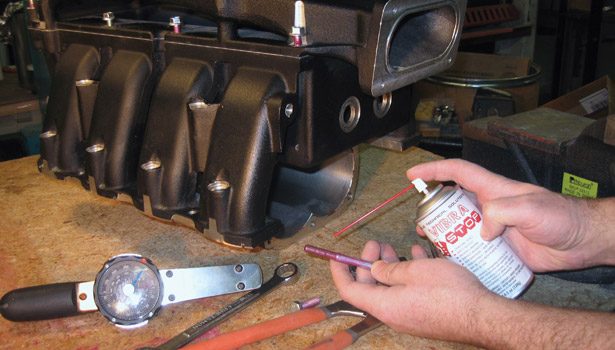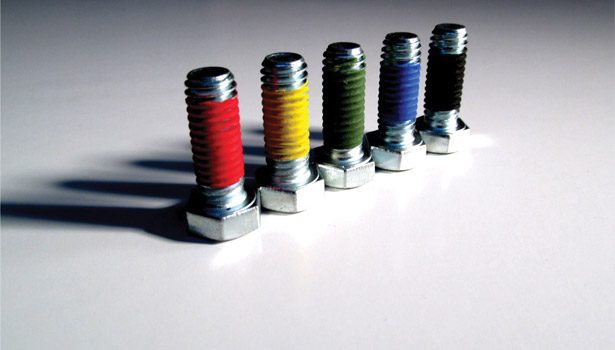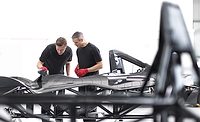The concept of using helical threaded fastening dates back many centuries. Nearly as old is the consequential search for a means of keeping these same fasteners secure until removal is required. Although this characteristic is seemingly the most desirable, any weekend mechanic knows the opposite is usually true: it only stays together when you need to take it apart.
Fastener enhancement products are traditionally comprised of the most basic concepts, including cotter pins and deformed components for locking, and messy greases and anti-seize products for lubricating. In recent decades, adhesives and coatings of higher technology have come into play, making strides in the reliability of fastener systems. Today, various new highly specialized product choices and wider application opportunities are available.
Fastener Locking Adhesives
Adhesives as locking elements can be most broadly subdivided into two general categories: pre-applied, long before the intended installation (applied to mass quantities of fasteners by fastener coaters), and bottled (applied to the joint at the time of assembly). Pre-applied products do not impart any performance properties that cannot be found in a bottle; however, the advantage is in the pre-application itself. The time saved through the pre-application of adhesives (and the resulting direct economic pay-back), along with the assurance that an adhesive is not inadvertently missing from a joint, are indispensable elements in mass assembly.
Pre-Applied Threadlocking Adhesives
Pre-applied adhesives became widely accepted in the early 1970s. Prior to this, adhesives were not highly looked upon, instead being considered less dependable than the more “tangible” mechanical methods. Although many products are available on the market, each falls into one of two chemical groups: epoxy or acrylic technology.
Basically, epoxy-based adhesives used for fasteners are quite similar to two-part epoxy kits available in the hardware store. Typical fully cured epoxies are the most durable, chemically resistant, versatile and tough adhesives known. However, delivery of these components to the right place in the correct proportion and without allowing the reaction until the right moment are all enormous hurdles to overcome.
A technology formerly used only in pharmaceuticals and printing called “microencapsulation” held the key to the problems of component separation. Microencapsulation involves encasing a material within an impermeable microscopic shell, not unlike a miniature egg. Microcapsules are widely used in consumer products such as scratch-and-sniff swatches, perfume samples and “carbonless” copy paper. Only close examination with a microscope will reveal clusters of spheres dispersed throughout the thread deposit.
The acrylic types of adhesives were a venture in making standard forms of bottled threadlockers fit into the pre-applied mold. One largely accepted misconception involving these products is the use of the term anaerobic, meaning “absence of oxygen.” This is often used to describe bottled threadlockers, as the absence of oxygen in the tight confines between the fastener and the mating part causes the adhesive to cure.
This is not the same reaction mechanism that takes place in pre-applied threadlockers. Most of the pre-applied threadlockers based on acrylic and methacrylic functionality are initiated in a distantly similar fashion to the microencapsulated technology previously discussed. The active ingredients to this style of adhesive are very similar to materials one would use for fiberglass auto or boat repair, even more distantly to the adhesives used for windshield repair and rear view mirror mounting. Unlike the epoxy system, the main initiator is encapsulated, rather than the matrix forming resin. Once all components are present in an active state, their reaction will proceed regardless of the presence or absence of oxygen.
This type of system offers several positive benefits, the most outstanding of which is cure speed. Some removal torque may be detected as early as 10 min after installation. Other notable factors include the water-based application medium and an ability to achieve high breakaway torque.
User-Applied Point of Assembly Materials
Modern fastener retaining took its biggest leap forward with the development of liquid threadlocking adhesives. Anaerobic adhesives, as they are sometimes called, are “triggered” (or initiate reaction) by the absence of oxygen contact, hence the name “anaerobic.”
Many choices are available for the users of these types of products: low or high strength, removable or permanent, high temperature, penetrating, high or low viscosity, thixotropic, fast or slow cure, low friction, red, green, yellow, blue, and purple, to name a few. Regardless of grade, whether permanently retaining a stud in an engine block or installing a serviceable pipe plug in a refrigerator, they are all based on the same chemistry.
Recent innovations include a variety of non-anaerobic threadlocking materials. This encompasses a number of user-applied materials that mimic hard-to-get pre-applied products previously only available through professional service centers. In addition to ease-of-use packaging, many are friendly to special substrates, temperature-sensitive platings and plastics, where anaerobic adhesives cannot be used.
In addition to threaded fasteners, many products of this new breed are finding use in new types of applications on splines, pulleys and moving assemblies, offering a “cushioning effect” to mitigate squeak and rattle for noise, vibration and harshness (NVH) improvement.
This type of system offers several positive benefits, the most outstanding of which is cure speed. Some removal torque may be detected as early as 10 min after installation. Other notable factors include the water-based application medium and an ability to achieve high breakaway torque.
Component Surface Sealing and Lubrication
Mobile phones and electronic devices, along with the use of high-tech engineering materials, have created a need for improved adhesive, coating, and sealant performance. The ubiquity of smartphones has taken for granted that the materials contained in, and facilities where these items are made, must also be as high-tech as the final articles themselves.
Many electronics require a cleanroom environment when they are assembled, and components both within the device and the assembly room cannot emit even the tiniest particles at any point during their lifetime. Without proper qualification of materials and assembly, any item with a display or lens could be clouded by vapor deposits, electronics would short circuit from conductive chips, and memory media damaged by particles.
This is a monumental challenge when components are made from filled plastics and metals, where the slightest frictional contact can produce a loose burr, chip or fiber particle. A number of products for surface sealing and enhancement have been specifically designed to mitigate particle and outgassing from any number of substrates used in highly sensitive environments.
Similarly, new high-tech engineering materials such as carbon fiber and specialized alloys can offer unexpected galvanic corrosion challenges not previously experienced with steel. Fasteners coated with specialized dielectric materials prevent situations from arising that might not be detected for months or years.
High-Tech Solutions
Chemical coatings and component enhancement materials like adhesives and sealants are often considered an afterthought or perhaps a low-tech Band-Aid® for nagging assembly issues. By simply scratching the surface of this topic, however, one can see that the technology in the adhesive or coating often far exceeds that of the component.
For more information, contact the author at (586) 232-3999, email info@tectorius.com or visit www.tectorius.com.







